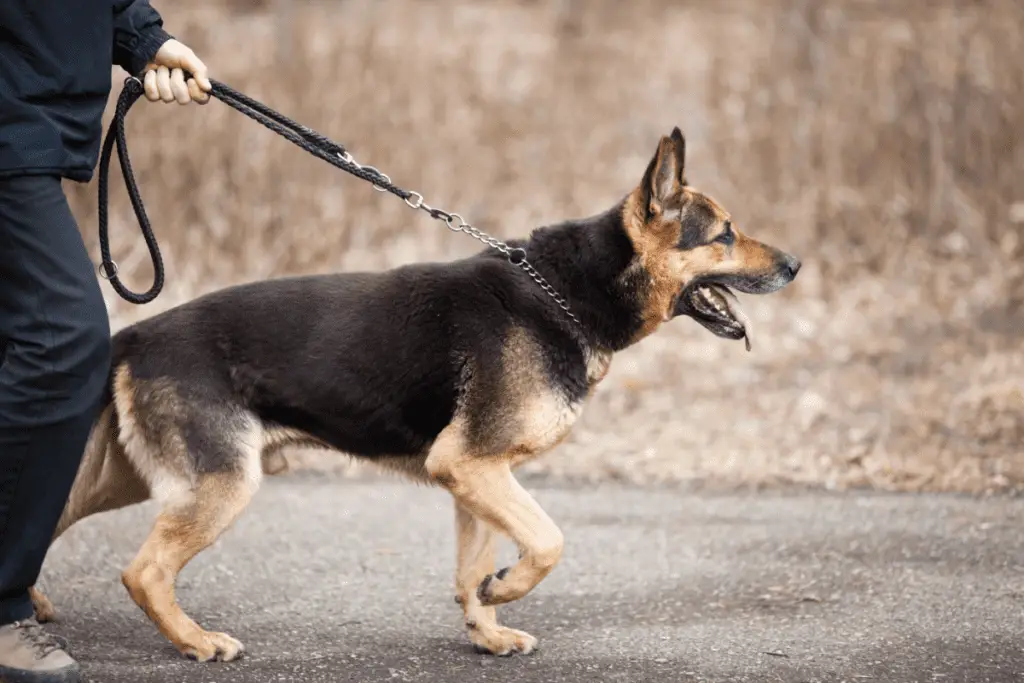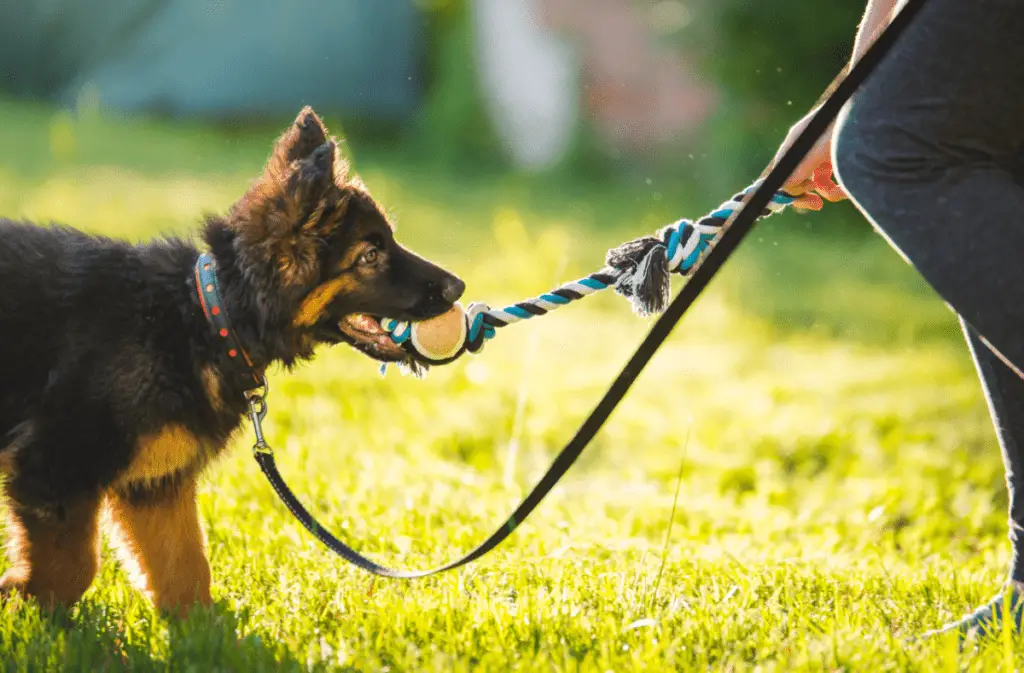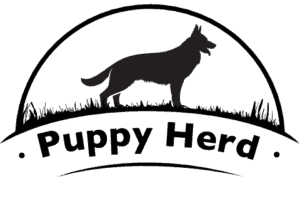The leash is an electrifying object for most dogs because it means it’s time for their favorite thing – a walk! They get to go outside, see new people, hear strange sounds, and investigate unfamiliar smells – all very exciting. German Shepherds are powerful dogs and walks with them can be an altogether different, unpleasant experience for you if your dog pulls and bites at the leash.
To stop your German Shepherd from biting the leash, you need to leash train them. When your dog bites at the leash, freeze – do not get pulled along and do not tug back. Use a voice command that you have trained, like “drop it” and when they stop biting, reward them with a treat and continue the walk.
It is essential that you train your German Shepherd to walk comfortably next to you on a leash. You, as the owner, need to set the boundaries for your dog and teach them which behaviors are acceptable and which are not. Knowing the boundaries makes your dog feel safe and secure. You need to make a real commitment to training because it takes time, consistency, and effort, but in the long run it will benefit your relationship with your dog enormously.

Why Do German Shepherds Bite Their Leash?
To address leash biting effectively, we need to first identify the underlying cause of the behavior. There are different reasons that dogs bite their leash and the methods of addressing the issue vary depending on the root cause. German Shepherd Dogs (GSDs) generally bite their leash for one of four reasons:
- Attention-seeking
- Wanting to play
- Being overstimulated
- Feeling frustrated
It can be really frustrating trying to take your dog for a nice walk but feeling as if they are fighting you the entire way. Remind yourself that they do not hate walking on a leash, and they are not intentionally being difficult. Dogs need you to teach them how to behave when they are being walked on a leash.
Leash Biting Due To Attention-Seeking
Unfortunately, we tend to pay more attention to our dogs when they are doing something naughty than when they are behaving well. We are quick to stop them when they are digging up the garden, chewing on their leash or jumping on the couch, but do not praise them when they are quietly lying in their bed or not destroying flower beds. Dogs crave our attention whether it is negative or positive.
When they are walking on their leash and not biting at it, reward them with a treat! One should always carry a handful of treats when you and your dog go walking so that you can reward good behavior, thereby conditioning them to behave well.
Leash Biting As Play
Puppies and young dogs have loads of energy and love to play. Their leash – an already exciting object – looks like a fun toy to tug on when it’s dangling or moving. When they grab the leash, shake their head from side to side, and give a little growl, they are just trying to play.
If you resist their biting and pulling it reinforces the behavior, because to them, it seems as if you are playing along. To make biting the leash less attractive, provide your dog with a fun diversion like a toy. When they start biting the leash, bring out their toy and get them to engage with that rather than the leash.
Ensure that your GSD gets enough exercise and mental stimulation throughout the day. If they have too much energy when they go for a walk, they are more likely to misbehave. Give them toys that are interactive and contain treats, where they must figure out how to get the treats out.

Leash Biting Due To Overstimulation
For dogs that are left alone at home while their owners are at work, the highlight of their day is when you come home. They get overexcited – jumping up against you, barking or biting at your clothes. Taking your dog for a walk when they are in this overexcited state is a bad idea for two reasons: they will feel overstimulated when they get outside and misbehave on their leash (biting it!), and by rewarding their overexcited state you reinforce the behavior.
When you come home from work, be very boring. Ignore your dog until they have calmed down. Reward their calm behavior with treats and then allow them to burn their energy with an activity like fetch. When your dog is less energetic, it is time to take them on their walk. Start off with a calm walk in a quiet environment with fewer triggers like other dogs and people, and then go for a regular walk. Always reward them with treats when they are walking calmly on the leash.
Leash Biting Due To Frustration
Dogs see and smell all sorts of interesting things when they are out walking with you and it is natural that they want to investigate. Your GSD may bite and pull on their leash when you are preventing them from sniffing some bushes or running across the street to greet another dog. In these situations, dogs get frustrated, but we must teach them that they cannot always get what they want.
Train alternative behaviors, such as “heel” or “sit” and reward them when they shift their attention back to you.
Choosing The Right Leash And Collar For Your German Shepherd
GSD puppies have razor sharp little teeth that can quickly chew through most objects. When buying a leash, choose one that is made of a strong material with high quality snap clip mechanisms. Choose a short leash, 6 foot is ideal, so that you have more control. Do not buy a retractable leash for your GSD, as they create a communication gap between you and your dog and gives them too much freedom. With a short, nylon or leather leash you can give a quick pull to convey to your dog that they are walking in the wrong direction. This is not possible with a retractable leash.
Avoid metal choke chains, unless you are a professional dog trainer. Used incorrectly, they can hurt your dog’s throat and neck. This is especially true for GSDs because they are so strong. Choke chains are intended for training only, not daily use.
Leash training Tips For German Shepherds
- Start early – socialize them well. Do not wait until they are old enough for puppy school. The training window for classical conditioning is from 6-16 weeks. After that, training becomes more difficult, but not impossible!
- Start leash training indoors where there are fewer distractions. Use high value rewards to encourage focus and compliance.
- Be consistent and train every day. Choose short, simple command words and train them well – don’t shout or scream at your dog, as you will either scare them or excite them.
- Reward good behavior (positive reinforcement), but do not punish bad behavior. This will break your dog’s trust in you. Never physically punish your dog (hitting, holding down, dragging).
- Play with them before leash training – less energy and overstimulation.
- Be patient, stay calm.
Tips To Stop Leash Biting Behavior
- When it happens, stop the walk. Never engage in a tug of war. Do not pull the leash away, as this rewards the behavior and will encourage your dog to bite more.
- Use a trained command word and wait until they comply. Reward generously when your dog stops biting.
- Continue the walk and reward good walking without pulling or biting at the leash.
- Give them an object like a tennis ball to carry during the walk. This will keep their mouth occupied.
Final Thoughts
The best way to solve the problem of leash biting is through dedicated and consistent leash training. Never pull back when your German Shepherd is leash biting, as this will encourage them. Train a command word and an alternative behavior for when they are biting the leash. Reward your dog when they are behaving well and walking calmly next to you. Positive reinforcement is far more effective for classical conditioning. Punishing your dog only damages your relationship.
